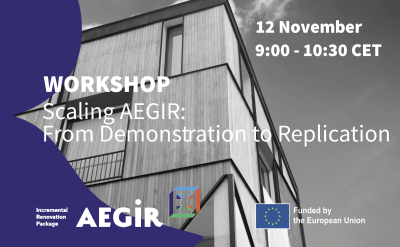News

How can we improve the energy performance of commercial buildings?
On October 9, Tenerrdis joined forces with ATEE Auvergne Rhône Alpes, Schneider Electric and Ademe to organize an event at Schneider's Intencity premises, an after-midday session dedicated to the energy performance of commercial buildings.
Context
Regulations require commercial property owners to significantly reduce the energy consumption of their buildings (-40% by 2030). The thermal comfort of commercial buildings impacts their attractiveness. How can the energy performance of these buildings be improved? What solutions should be implemented? How can the necessary actions be organized? These were the questions that the event was designed to answer, with some fifty participants taking part.

Introduction
By way of introduction, Planair (which supports companies, public authorities and the private sector in the energy and climate transition), has drawn up an overview of the environmental, economic, technical and regulatory issues at stake:
In France, commercial buildings account for almost one billion m², including 380 million m² for public buildings. Service sector buildings represent only a quarter of the existing building stock. However, they currently account for a third of final energy consumption and a third of greenhouse gas (GHG) emissions in the real estate sector.
Energy consumption in commercial buildings is :
- 64% due to climate-related uses:
- 46% heating,
- 9% cooling / air-conditioning,
- 9% domestic hot water.
- 27% due to specific uses: lighting, IT, digital...
- 5% from cooking,
- 4% from other uses.
By way of introduction, Planair (which supports companies, public authorities and the private sector in the energy and climate change transition), gave an overview of the environmental, economic, technical and regulatory issues at stake:
In France, commercial buildings account for almost one billion m², including 380 million m² for public buildings. Service sector buildings represent only a quarter of the existing building stock. However, they currently account for a third of final energy consumption and a third of greenhouse gas (GHG) emissions in the real estate sector.
Energy consumption in commercial buildings is :
- 64% due to climate-related uses:
- 46% heating,
- 9% cooling / air-conditioning,
- 9% domestic hot water.
- 27% due to specific uses: lighting, IT, digital...
- 5% from cooking,
- 4% from other uses.
Financing solutions
This was followed by a round-table discussion on public and private financing tools, during which Grenoble Métropole presented its free service to support companies in their energy renovation projects for their built assets. Grenoble-Alpes Métropole provides up to €50,000 in financing for energy renovation work, and also helps businesses to access other assistance and support from ADEME, Bpifrance, CMA Auvergne-Rhône-Alpes and the Grenoble Chamber of Commerce and Industry, which were also presented.
Feedback
4 companies were also able to give feedback on their experience: SAS Triplan and Bati TP,ALEC Grenoble, ERGTP and BPAURA on their support.
A final round-table discussion looked at how to implement a renovation strategy. Various solutions were discussed: energy audits, digitization of the building stock, the role of the project manager, building management tools and photovoltaic self-consumption.
Intencity: a Schneider Electric building, a model of energy performance
The afternoon included a tour of Schneider Electric's Intencity building.
Innovative, connected and intuitive, Intencity accommodates 1,500 employees in 26,000 m2 of office space, and sets an example in terms of energy performance.
In the restaurant area, for example, Saint-Gobain glazing lets you adjust opacity: high in summer to reduce heat, low in winter to let in the calories emitted by the sun. Opacity is automatically adjusted according to weather forecasts.
Energy expenditure linked to climatic usage is optimized: for example, heat from the data centers is conserved for use in useful areas (showers reserved for employees). Water is drawn from groundwater to regulate building temperature. The building's intelligence collects thousands of pieces of data - at a rate of 60,000 every 2 minutes! - for comfort and energy optimization. Intencity is a learning building, adapting in real time to energy consumption, based on predictive data. It can, for example, put an entire floor or an unused open space to rest, and avoid unnecessary consumption.
Intencity is capable of offsetting its low energy consumption (37 kWh/m²/year, compared with an average of 330 kWh/m²/year for the European tertiary sector) with local energy production, thanks to over 4,000 m² of photovoltaic roof panels and two wind turbines. Finally, it is capable of interfacing with other buildings in the district, but also of shutting down in the event of electricity peaks, storing the renewable energy produced and deferring its consumption for the benefit of neighboring buildings.
Click here to see the photo report:













No comment
Log in to post comment. Log in.